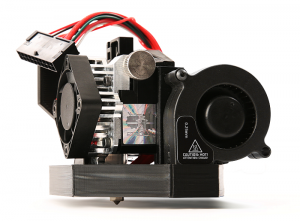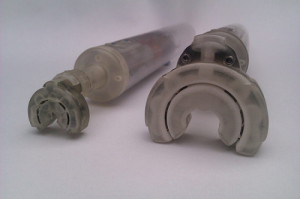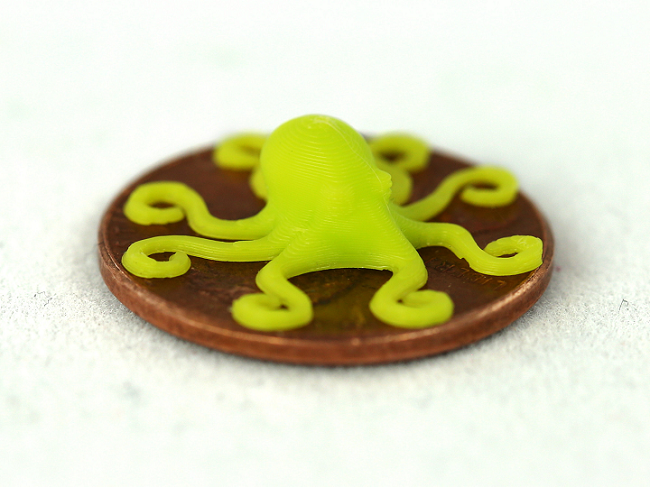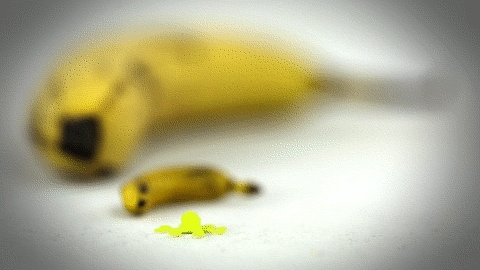Aleph Objects Introduces New Aerostruder v2 Micro For Highly Detailed, Tiny 3D Printed Parts
This spring, at RAPID 2018 in Texas, Aleph Objects introduced the LulzBot Mini 2, with a belt-driven Z-axis and several accessories, including the LulzBot modular bed system and a next generation Aerostruder Tool Head designed around the E3D Titan Aero hot end and extruder. Now, the company has introduced a new tool head – the Aerostruder v2 Micro, capable of accurately 3D printing parts the size of a penny and demonstrated this week at SIGGRAPH 2018 in Vancouver.
“Many LulzBot users, seeking finer print resolution, have installed after-market nozzles with varying success. However, delivering a reliable high resolution FFF printing experience is not just about swapping out the nozzle. First it requires the best extruder and hot end on the market, which we’ve found in the E3D Titan Aero. From there it’s all about utilizing our knowledge of material properties and thousands of hours of printing experience to hone print profiles that are then extensively tested,” Aleph Objects Product Specialist Adam Straight told 3DPrint.com.
“Frankly, I think some of us are still shocked at the detail possible with this tool head. We’re seeing details on models that weren’t visible before, and we’re printing things that weren’t possible before!”
 The Aerostruder v2 Micro Tool Head, which is compatible with the LulzBot Mini 2 3D printer, makes it possible to create extremely precise, finely detailed 3D prints, thanks to the genuine E3D Titan Aero Extruder/Hot End that Straight mentioned. The Titan Aero, with a 0.25 mm nozzle, offers 360° part cooling, which the company says can create detailed prints with great bridge and overhang performance.
The Aerostruder v2 Micro Tool Head, which is compatible with the LulzBot Mini 2 3D printer, makes it possible to create extremely precise, finely detailed 3D prints, thanks to the genuine E3D Titan Aero Extruder/Hot End that Straight mentioned. The Titan Aero, with a 0.25 mm nozzle, offers 360° part cooling, which the company says can create detailed prints with great bridge and overhang performance.
UK-based E3D Online Ltd., which develops and manufactures premium 3D printer components, has been partnering with Aleph Objects for two years now. Both companies share the same commitment to developing open source hardware for 3D printing.
“Aleph Objects probably [has] the most useful and interesting array of tool heads for their 3D printers, and E3D is excited to contribute its expertise to a tool head that really pushes the limits of the technology – it’s a lot of fun collaborating with a like-minded company that also trusts their users to really engage openly and freely with the technology,” said Sanjay Mortimer, the Co-Founder and Director of E3D Online Ltd. “There’s a lot more to come from this collaboration, and we feel like we’re just getting started.”
This new tool head is an excellent option for 3D artists, designers, and engineers who want increased surface quality and detail. It allows users to 3D print accurate parts at the penny-scale, while also providing the reliability and convenience that the company’s LulzBot ecosystem is well-known for providing.
“The Aerostruder v2 Micro Tool Head—paired with the LulzBot Mini 2 3D Printer—has changed my perception of what is possible with filament 3D printing,” said Straight. “In terms of resolution and surface finish, the prints from this new tool head are very impressive. The precision of E3D Titan Aero extruders and hot ends complements the premium quality built into every LulzBot 3D Printer.”
The Aerostruder v2 Micro Tool Head from Aleph Objects was showcased, together with the LulzBot Mini 2, at the company’s SIGGRAPH 2018 booth earlier this week. A “micro art gallery” of 3D printed miniature art exhibits was also on display, to show what the new tool head is capable of. The Aerostruder v2 Micro should be available for purchase by the end of next month. If you’d like to be notified when this new product is released, you can sign up here.
What do you think about this new product? Discuss this story, and other 3D printing topics, at 3DPrintBoard.com, or share your thoughts in the Facebook comments below.
[Images provided by Aleph Objects]
LulzBot releases 3D Aerostruder Micro Tool Head for “penny-scale” 3D printed parts
3D Printing News Briefs: August 10, 2018
We’ve got some business news to start things off with in today’s 3D Printing News Briefs, followed by a little research and a really cool 3D printed costume. The Department of Defense has awarded a contract to Contour Crafting, and Sutrue is celebrating its tenth anniversary. Facebook has made the decision to ban blueprints for 3D printed guns, and a Siggraph paper takes an in-depth look into near-eye displays. Finally, several companies helped the non-profit organization Magic Wheelchair make a really cool 3D printed wheelchair costume for a big Star Wars fan.
Contour Crafting Receives Department of Defense Contract
 One of the first methods of large-scale 3D printing, Contour Crafting, uses large but lightweight robotic 3D printers, which can quickly put down layers of building material to rapidly create entire buildings onsite in just days. The California-based corporation itself is on a mission to commercialize disruptive construction technologies, and we recently learned that the US Department of Defense (DoD) has awarded Contour Crafting a $3 million research and development contract to build a concrete 3D printer for the purposes of building construction for disaster relief.
One of the first methods of large-scale 3D printing, Contour Crafting, uses large but lightweight robotic 3D printers, which can quickly put down layers of building material to rapidly create entire buildings onsite in just days. The California-based corporation itself is on a mission to commercialize disruptive construction technologies, and we recently learned that the US Department of Defense (DoD) has awarded Contour Crafting a $3 million research and development contract to build a concrete 3D printer for the purposes of building construction for disaster relief.
According to the company’s website , “Effective 25 JUL 2018, the Department of Defense has awarded Contour Crafting Corporation with a Rapid Innovation Fund contract in the domain of large and construction scale 3D printing. The outcome of this funded R&D program is expected to be a technology which, among other applications, will effectively respond to disaster relief situations with expedient, safe and sustainable structures and buildings.”
This information confirms that the DoD is not putting all of its eggs into one basket, so to speak, and is seeking outside help for its construction 3D printing goals.
Sutrue Celebrates Ten Years
 Medical device startup Sutrue first started working on a 3D printed suture stitching device to help prevent needle stick injuries back in 2014, and became the first company to successfully 3D print a suture device. But Sutrue’s story actually began back in August of 2008, when its founder Alex Berry was stuck at home with a broken ankle and watched a documentary that provided some insight into robotic suturing. In an effort to keep busy during his recovery, Berry, who had some basic CAD knowledge, got to work.
Medical device startup Sutrue first started working on a 3D printed suture stitching device to help prevent needle stick injuries back in 2014, and became the first company to successfully 3D print a suture device. But Sutrue’s story actually began back in August of 2008, when its founder Alex Berry was stuck at home with a broken ankle and watched a documentary that provided some insight into robotic suturing. In an effort to keep busy during his recovery, Berry, who had some basic CAD knowledge, got to work.
After moving to the UK, Berry officially started Sutrue in 2012, meeting some influential people along the way who helped him get closer to achieving his goal of creating a 3D printed suture device. The startup completed a £30,000 crowdfunding campaign in 2014, submitted another patent, developed a few mutually beneficial relationships with other companies, and secured further funding for continued device development. Now, Sutrue is celebrating the 10th anniversary of Berry’s initial idea.
The startup wrote in a post, “It’s been ten years of ups and downs, filled with much uncertainty particularly in the first five years in which Berry didn’t even know for sure that the device would work. He has maintained the progression of the device through having a healthy dose of insanity, extreme resourcefulness, and an inquiring and problem-solving mind. He’s gone against many societal norms to have created two working prototypes of his automated suturing device – the robotic and the handheld, but as the route to market becomes closer and closer, he’s glad to have fought against the odds to see the project through to completion.”
Facebook Bans 3D Printed Gun Blueprints
There’s been an increased amount of conversation on the topic of 3D printed guns recently, after news broke of a settlement between the US State Department and Texas open source 3D printed gun designer Defense Distributed, run by Cody Wilson. The settlement states that Wilson and his non-profit organization can publish files, plans, and 3D drawings of guns in any form, and are also exempted from export restrictions; additionally, the government will be paying nearly $40,000 of Wilson’s legal fees. This means that people who weren’t legally able to purchase firearms before, such as felons and domestic abusers, can 3D print their own guns without serial numbers. As you can imagine, many are not happy with this decision. This week, Facebook, the world’s largest social network, said that it will ban any websites that host and share blueprints of 3D printed guns, though the designs have already been available online for years.
According to BuzzFeed News, a Facebook spokesperson said, “Sharing instructions on how to print firearms using 3D printers is not allowed under our Community Standards. In line with our policies, we are removing this content from Facebook.”
MSN reports that Facebook did not “immediately respond to a request for comment regarding the Ghost Gunner” 3D printed gun.
Siggraph Paper on Optical Design for Augmented Reality Near Eye Displays
 This year’s annual conference on computer graphics, SIGGRAPH 2018, starts this Sunday, August 12th, in Vancouver. One of the papers published for the conference, titled “Steerable application-adaptive near eye displays,” discusses see-through near eye displays (NED), which are currently being used in the Hololens, among other things. According to the Stanford Computational Imaging Lab, most NEDs work by using a stereoscopic image pair to optically drive the visual system’s vergence state to “arbitrary distances,” but drives the focus (accommodation) state towards a fixed distance.
This year’s annual conference on computer graphics, SIGGRAPH 2018, starts this Sunday, August 12th, in Vancouver. One of the papers published for the conference, titled “Steerable application-adaptive near eye displays,” discusses see-through near eye displays (NED), which are currently being used in the Hololens, among other things. According to the Stanford Computational Imaging Lab, most NEDs work by using a stereoscopic image pair to optically drive the visual system’s vergence state to “arbitrary distances,” but drives the focus (accommodation) state towards a fixed distance.
The technology is a bit of a long shot, due to people getting motion sickness or their eyes getting tired, but if we can get it to work, I bet every movie theatre in the world will employ it.
The abstract of the paper reads, “The design challenges of see-through near-eye displays can be mitigated by specializing an augmented reality device for a particular application. We present a novel optical design for augmented reality near-eye displays exploiting 3D stereolithography printing techniques to achieve similar characteristics to progressive prescription binoculars. We propose to manufacture inter-changeable optical components using 3D printing, leading to arbitrary shaped static projection screen surfaces that are adaptive to the targeted applications. We identify a computational optical design methodology to generate various optical components accordingly, leading to small compute and power demands. To this end, we introduce our augmented reality prototype with a moderate form-factor, large field of view. We have also presented that our prototype is promising high resolutions for a foveation technique using a moving lens in front of a projection system. We believe our display technique provides a gate-way to application-adaptive, easily replicable, customizable, and cost-effective near-eye display designs.”
Co-authors of the paper are NVIDIA Corporation‘s Kishore Rathinavel, Praneeth Chakravarthula, Kaan Akşit, Josef Spjut, Ben Boudaoud, Turner Whitted, David Luebke, and Henry Fuchs from UNC Chapel Hill.
3D Printed Star Wars Wheelchair Costume
 Here’s something fun and heartwarming to kick off your weekend – non-profit organization Magic Wheelchair, which makes free, bespoke wheelchair costumes for kids, created a 3D printed Poe Dameron X-Wing Fighter wheelchair costume for a 13-year-old, wheelchair-bound Star Wars fan named Vedant Singhania to wear at last month’s Comic-Con International. Project partners included Pixologic, which used its ZBrush digital sculpting software to provide the design and modeling work, and Dangling Carrot Creative, which used the high print speeds of the Massivit 1800 3D printer to make 50 separate costume pieces in a little over two weeks. Massivit also donated 3D printing materials, and Monster City Studios assembled the large wheelchair costume.
Here’s something fun and heartwarming to kick off your weekend – non-profit organization Magic Wheelchair, which makes free, bespoke wheelchair costumes for kids, created a 3D printed Poe Dameron X-Wing Fighter wheelchair costume for a 13-year-old, wheelchair-bound Star Wars fan named Vedant Singhania to wear at last month’s Comic-Con International. Project partners included Pixologic, which used its ZBrush digital sculpting software to provide the design and modeling work, and Dangling Carrot Creative, which used the high print speeds of the Massivit 1800 3D printer to make 50 separate costume pieces in a little over two weeks. Massivit also donated 3D printing materials, and Monster City Studios assembled the large wheelchair costume.
“We connected with Magic Wheelchair because we knew our technology and modelling expertise could assist them with the fantastic work they are doing for children in wheelchairs,” said Pixologic’s 3D Product Development Manager Paul Gaboury. “After we designed the costume, Dangling Carrot Creative was the final piece to the puzzle. The company allowed us to 3D print life-size to help remove the need for molds or casting which saves substantial time and money.”
Discuss these stories, and other 3D printing topics, at 3DPrintBoard.com or share your thoughts in the Facebook comments below.





